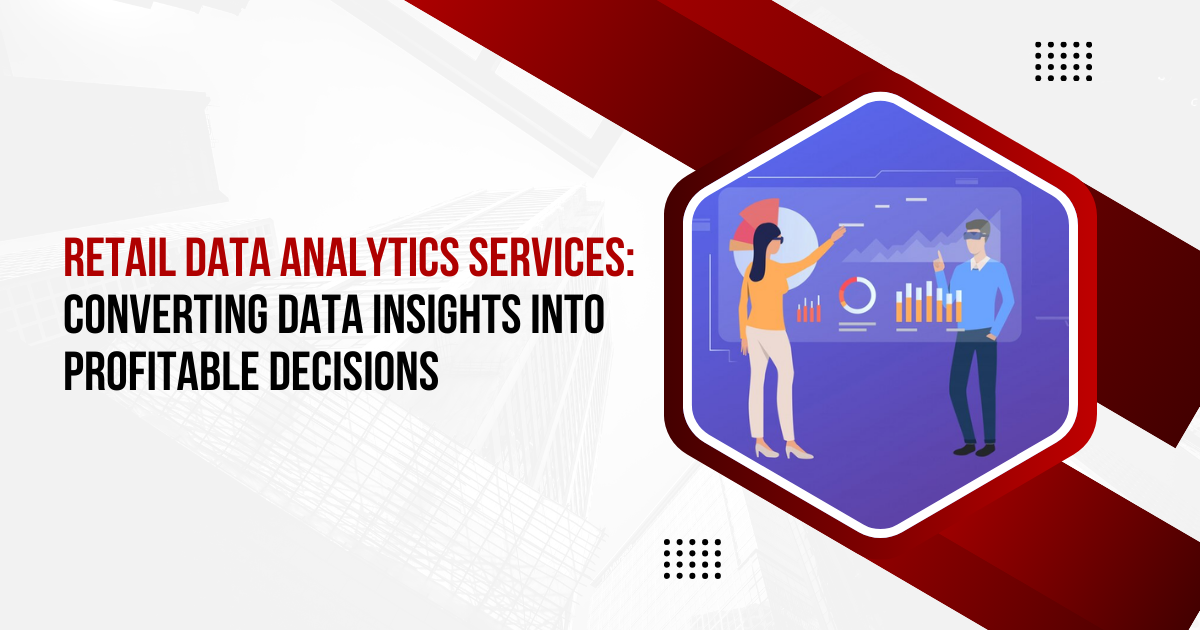Today’s retail industry is fast-moving and highly competitive. Businesses deal with an overwhelming amount of data daily. Every purchase, website visit, social media comment, and supply chain activity creates valuable information. However, this data only becomes useful when it is properly collected, analyzed, and applied.
Retail Data Analytics Services play a major role in this transformation. These services help businesses understand customer behaviors, forecast trends, and optimize operations. The end result is better decision-making, leading to improved profits and customer loyalty.
According to McKinsey, companies that use data-driven decision-making increase their profits by up to 20% compared to competitors.
What is Retail Data Analytics?
Retail Data Analytics refers to the use of tools and techniques to gather, organize, and examine data from various retail activities. These include sales transactions, customer feedback, inventory levels, marketing campaigns, and more.
The main goal is simple: Convert raw data into clear, useful insights that drive better business actions. Retailers who effectively use data analytics can make smarter pricing decisions, improve customer experiences, and manage their inventory more efficiently.
Why Retail Data Analytics Services Matter
The retail industry is undergoing major changes. Shoppers today expect faster service, personalized experiences, and greater convenience. At the same time, competition has intensified. New players enter the market daily, and online shopping options have multiplied. Mobile commerce has added more complexity, making it necessary for retailers to manage both physical and digital channels effectively.
In this fast-paced environment, relying on traditional decision-making methods is no longer enough. Businesses must use precise, data-driven strategies to stay competitive. Retail Data Analytics Services play a vital role in this transformation by providing accurate, real-time insights that guide better actions.
Let’s explore the critical areas where Retail Data Analytics Services add real value:
1. Better Demand Forecasting
Predicting customer demand accurately is a key factor in retail success. Overstocking leads to high inventory costs and waste. Understocking causes lost sales and dissatisfied customers.
Retail Data Analytics Services use historical sales data, seasonality patterns, and market trends to forecast future demand more precisely. This allows retailers to plan better, reducing both surplus inventory and missed sales opportunities.
Example: A sportswear retailer using predictive analytics adjusted its stock based on local weather forecasts. As a result, it achieved a 15% increase in seasonal product sales.
2. Improved Customer Targeting
Understanding customer preferences helps in creating personalized experiences. Retailers can segment their audiences based on factors like:
- Purchase history
- Browsing behavior
- Demographic information
- Location
Retail Data Analytics Services enable targeted marketing campaigns that speak directly to individual customer needs. This increases engagement, builds loyalty, and improves conversion rates.
Fact: According to Epsilon, 80% of consumers are more likely to purchase when brands offer personalized experiences.
3. Real-Time Inventory Management
Inventory issues can make or break a retail business. Poor inventory management leads to stockouts, overstock situations, and unhappy customers.
With real-time tracking through Retail Data Analytics, businesses gain full visibility over their inventory across all locations. They can monitor stock levels, identify slow-moving products, and optimize replenishment processes.
Example: Large retailers like Walmart have adopted real-time inventory tracking, reducing out-of-stock products by nearly 16%.
4. More Effective Marketing Campaigns
Marketing is no longer just about reaching a large audience. It is about reaching the right audience at the right time with the right message.
Using Retail Data Analytics Services, businesses can measure the effectiveness of marketing efforts across different channels. They can:
- Test different promotional strategies
- Measure customer responses in real time
- Adjust campaigns based on performance metrics
Fact: Campaigns based on data-driven strategies are reported to have 5-8 times the return on investment compared to traditional campaigns (Source: Forbes).
5. Smarter Supply Chain Decisions
Retailers rely heavily on their supply chains. Delays, bottlenecks, or supplier failures can severely impact sales.
Retail Data Analytics allow businesses to:
- Track shipments
- Analyze supplier performance
- Predict potential delays
- Choose better logistics partners
By using analytics, companies can make faster, more informed supply chain decisions that minimize risks and costs.
Example: Nike uses supply chain analytics to improve its sourcing and distribution strategies, helping reduce delivery times and logistics costs by 10%.
Key Areas of Retail Data Analytics
Retail Data Analytics is a broad and vital field that touches every part of a retail business. Companies use it to better understand customers, improve sales performance, manage inventory, and strengthen their supply chains. Each of these areas plays an important role in helping businesses make smarter decisions and stay competitive in a fast-changing market.
1. Customer Analytics
Customer analytics focuses on deeply understanding who the customers are and how they behave. Retailers use this area of analytics to group customers based on key factors such as age, location, and buying habits. By doing so, they can better tailor products and services to meet different customer needs. Predictive models help businesses forecast what customers might want next, enabling more personalized marketing efforts. Additionally, loyalty programs can be built around real purchasing behavior instead of assumptions, increasing customer retention. For instance, Starbucks collects customer data through its mobile app to offer customized rewards and promotions, leading to higher engagement and repeat purchases.
2. Sales Analytics
Sales analytics help retailers gain insights into how products perform across different channels and regions. Businesses use this type of analysis to identify their top-selling products, understand sales patterns by season or location, and test the effectiveness of promotions and discounts. Companies that use sales data effectively can achieve significant revenue growth. In fact, research shows that businesses leveraging sales analytics report an average revenue increase of 5–10% within a single year. By analyzing this data, retailers can make better decisions about pricing, marketing strategies, and product placements, all of which contribute to higher profitability.
3. Inventory Analytics
Managing inventory properly is crucial for maintaining both customer satisfaction and financial efficiency. Inventory analytics helps businesses avoid stockouts, which lead to lost sales, and overstock situations, which tie up valuable capital. Retailers can predict when to reorder items by analyzing sales patterns and stock levels. They can also identify slow-moving products and adjust their strategies to either promote or phase them out. A good example is Zara, which uses real-time inventory data to restock popular items quickly. This approach ensures that the most in-demand products are always available, helping the brand maintain strong customer loyalty and drive consistent sales.
4. Supply Chain Analytics
A reliable and efficient supply chain is critical for delivering products faster and at lower costs. Supply chain analytics provide businesses with the tools to monitor supplier performance closely, optimize logistics routes, and reduce delivery times. Through advanced analytics, companies can detect bottlenecks and make improvements before they become serious problems. According to Deloitte, businesses that apply supply chain analytics are able to cut their operating costs by up to 20%. By making supply chains more transparent and responsive, retailers can enhance their service levels and strengthen their market positions.
How Retail Data Analytics Services Work
Retail Data Analytics Services follow a step-by-step approach to transform scattered business information into valuable insights. The first and most critical phase is Data Collection. In this phase, data is gathered from many sources across the retail ecosystem. These sources include Point of Sale (POS) systems, e-commerce platforms, mobile apps, customer service chat systems, and social media interactions. Each platform provides unique insights about customer preferences, buying patterns, and product performance. Collecting data from a variety of touchpoints ensures that the analytics cover every aspect of the customer journey.
1. Once data is collected, the next step is Data Integration. This involves combining the gathered data into a centralized system. Without integration, different departments might work with fragmented information, leading to data silos. Centralizing the data allows analysts to access a full view of operations and customer behavior, enabling comprehensive analysis.
2. Following integration, the process moves to Data Processing. This is a critical step where the raw data is cleaned and organized for analysis. Common issues like missing values, duplicate entries, formatting errors, and inconsistencies are identified and corrected. Data quality is essential because even small errors can lead to wrong conclusions. During processing, the data is also standardized, making it easier to compare different datasets during analysis.
3. The next phase is Data Analysis. During this stage, advanced techniques are applied to extract meaningful patterns and trends. Predictive analytics models are used to forecast future sales and customer behavior. Machine learning algorithms identify hidden relationships that traditional analysis might miss. Analysts explore the data deeply to find insights that can help businesses predict demand, segment customers, optimize pricing strategies, and improve operational efficiency.
4. The final step is Insight Generation. After the analysis is complete, findings are translated into actionable insights. These insights are presented to decision-makers through dashboards, visual reports, and executive summaries. Clear visuals such as charts, graphs, and heatmaps help leaders quickly understand complex information. This enables companies to make informed decisions based on real evidence instead of assumptions.
Applications of Retail Data Analytics
1. Dynamic Pricing
is one of the most powerful uses of Retail Data Analytics. Retailers can adjust prices dynamically based on real-time factors like customer demand, willingness to pay, and competitor pricing strategies. Instead of setting fixed prices, businesses can optimize profits by reacting quickly to market changes. A well-known example is Amazon, which reportedly changes product prices up to 2.5 million times per day using its data analysis algorithms. By studying purchasing trends, product availability, and customer behavior, Amazon ensures that its prices stay competitive and profitable at all times.
2. Personalized Marketing
is another critical application that helps businesses connect more closely with customers. Using Retail Data Analytics, companies can segment their audience and send targeted messages based on shopping history, preferences, and behaviors. This approach leads to higher conversion rates, better customer satisfaction, and stronger brand loyalty. Personalization ensures that customers receive offers that are relevant to them, making them more likely to engage and buy. A report by Adobe highlights that personalization improves customer engagement by 30%, proving how critical it is for businesses that want to remain competitive in today’s crowded market.
3. Optimizing Store Layouts
Using data insights is a smart way to improve the customer shopping experience and boost sales. Retailers analyze how customers move through physical stores, where they spend the most time, and which paths they commonly take. This information helps businesses place products in high-traffic areas and design layouts that encourage impulse purchases. IKEA is a good example of this strategy. It carefully designs its store layouts based on customer walking patterns to expose shoppers to a wide variety of products, leading to more sales and longer store visits.
4. Omnichannel Integration
is also an essential part of modern retail strategies. It involves combining customer data from online websites, mobile apps, and physical stores to create a seamless shopping experience. When all channels are connected, retailers can track customer interactions across platforms and offer personalized services such as click-and-collect, personalized promotions, or unified customer support. A study shows that Target customers who shop both online and in-store spend four times more than those who use only one channel. This highlights the financial benefits of offering an integrated and consistent shopping journey across all touchpoints.
Challenges in Using Retail Data Analytics
1. Data Privacy
Data privacy is one of the biggest concerns in retail today. Customers are becoming more aware of how businesses collect and use their personal information. They expect complete transparency and control over their data. Retailers must not only be honest about their data practices but must also follow strict data protection regulations. Laws like the General Data Protection Regulation (GDPR) in Europe and the California Consumer Privacy Act (CCPA) in the United States require businesses to get explicit consent before collecting data. Retailers must also provide options for customers to access, modify, or delete their personal information. Failure to comply with these regulations can lead to heavy fines and a damaged brand reputation. Maintaining data privacy is essential for building customer trust and loyalty in a competitive market.
2. Data Quality
The quality of the data collected directly impacts the accuracy of the insights generated. If the data is inaccurate, incomplete, duplicated, or outdated, it can lead to wrong business decisions. Poor-quality data can cause retailers to misinterpret customer behavior, incorrectly forecast demand, or stock products that do not sell. Therefore, continuous data monitoring, validation, and cleaning are essential steps in any Retail Data Analytics project. Businesses must implement strict data governance practices to ensure data is collected correctly and remains consistent across all platforms. High-quality data enables better decision-making, improves operational efficiency, and enhances the customer experience.
3. Integration Difficulties
Retailers today use a variety of systems to manage sales, inventory, marketing, customer relations, and supply chains. Integrating data from all these different systems into a centralized platform is a complex task. Different platforms often store data in different formats, leading to compatibility issues. Integration requires careful planning, significant investment, and often custom-built software solutions. It also demands technical expertise to ensure that data flows accurately between systems without loss or corruption. If integration is not done properly, businesses risk creating isolated data silos where important information is trapped within one system and inaccessible to others. This limits the effectiveness of Retail Data Analytics and prevents businesses from gaining a complete view of their operations.
The Future of Retail Data Analytics Services: Trends, Innovations, and Predictions
As the retail industry evolves, so too does the role of data analytics. In an increasingly competitive marketplace, where understanding consumer behavior and optimizing operations are key to success, retail data analytics has become indispensable. Retailers are leveraging vast amounts of data to enhance their decision-making, improve customer experiences, and drive efficiency. The future of retail data analytics services is bright, and several key trends are set to shape the landscape in the coming years.
1. AI and Machine Learning: Predictive Power and Automation
Artificial Intelligence (AI) and Machine Learning (ML) are expected to revolutionize retail data analytics services. These technologies allow retailers to not only analyze data but also predict future trends, automate processes, and optimize decision-making in real time.
- Personalized Customer Experiences: AI and ML can help retailers analyze consumer behavior patterns, preferences, and purchase histories. This enables businesses to deliver hyper-personalized recommendations, marketing campaigns, and product offerings. By predicting customer needs before they arise, retailers can enhance customer loyalty and increase sales.
- Inventory Management and Supply Chain Optimization: AI-driven predictive analytics can forecast demand, optimize stock levels, and reduce waste. Machine learning algorithms can identify patterns in sales and supply chain data to improve inventory management and distribution strategies. This ensures that the right products are available at the right time, reducing both overstocking and stockouts.
- Automation of Routine Tasks: Machine learning can automate repetitive tasks such as customer support, demand forecasting, and fraud detection. Chatbots and virtual assistants powered by AI are becoming increasingly common, enabling retailers to enhance their customer service without additional manpower.
Stat to Know: According to a Gartner report, 75% of retail organizations will invest heavily in AI-driven analytics by 2026, signaling a major shift towards data-driven decision-making in the retail industry.
2. Edge Computing: Real-Time Data Processing Closer to the Source
Edge computing refers to the practice of processing data closer to where it is generated, rather than sending it to a centralized cloud server. This is particularly important in retail, where time-sensitive decisions need to be made quickly to enhance customer experience and improve operational efficiency.
- Improved Real-Time Decision Making: With edge computing, retailers can process data in real time at the point of sale (POS) or even within the store itself. For example, sensors on shelves or in store aisles can collect data on product availability, customer movement, and inventory levels, allowing for immediate action without waiting for cloud processing.
- Enhanced Customer Experiences: Edge computing enables personalized in-store experiences, such as automatic recognition of customer preferences or personalized promotions based on real-time interactions. For example, when a customer enters the store, their preferences could be pulled up in real-time to offer them tailored discounts or product suggestions.
- Reduced Latency and Increased Speed: Edge computing also reduces latency by processing data locally. This is essential for applications that rely on fast responses, such as automated checkout systems or smart mirrors. Retailers can deliver faster, more efficient services while minimizing the burden on their centralized servers.
3. Augmented Analytics: Empowering Business Users with Insights
The growing demand for self-service analytics tools has given rise to augmented analytics—an approach that uses AI and machine learning to automate data preparation and generate actionable insights. Augmented analytics aims to make analytics accessible to business users, not just data scientists or analysts, by providing tools that automatically explain insights in easy-to-understand language.
- Automated Insights for Business Users: Augmented analytics platforms automatically analyze large volumes of data and provide business users with actionable insights, without requiring technical expertise. For instance, rather than requiring an analyst to manually sift through data, augmented analytics can provide a visual representation of trends, anomalies, and performance indicators that are immediately usable for decision-making.
- Natural Language Processing (NLP): Many augmented analytics tools use NLP, enabling business users to ask questions in plain language. For example, a retail manager could ask, "What were our top-performing products last month?" and receive a detailed, understandable report with recommendations.
- Better Decision-Making with Fewer Resources: By automating data analysis and providing accessible insights, augmented analytics reduces the need for highly specialized technical skills and allows non-technical staff to make data-driven decisions. This enables organizations to democratize data and improve decision-making across departments, from marketing to inventory management.
4. Data Privacy and Security: Navigating the Growing Concerns
With the increasing reliance on data, especially personal customer information, data privacy and security are paramount concerns for retail businesses. The rise in data breaches and stricter regulations (like GDPR) will prompt retailers to invest in more robust data protection measures.
- Compliance with Data Protection Laws: Retailers will need to stay compliant with privacy laws and regulations to avoid heavy fines and reputational damage. Data encryption, secure data storage, and compliance audits will become standard practices for retailers handling sensitive customer data.
- Transparency and Consumer Trust: Retailers will need to be transparent about their data usage practices to build trust with customers. This may involve providing clear, easy-to-understand privacy policies and allowing customers to control their own data.
- Advanced Security Measures: With the rise of cyber threats, retail businesses will invest more in AI-powered security solutions that can identify and mitigate potential risks in real time. This might include fraud detection algorithms that analyze transactions for suspicious activity or biometric systems for in-store security.
5. Blockchain: Enhancing Transparency and Trust
Blockchain technology is increasingly being considered for retail data analytics because of its ability to provide transparent, tamper-proof records. This can be particularly useful in supply chain management and customer loyalty programs.
- Supply Chain Transparency: Blockchain can help ensure that data about product origins, movements, and conditions are accurately recorded and cannot be altered. Retailers can use this to verify the authenticity of products, ensuring they meet quality standards and reducing fraud.
- Customer Loyalty Programs: Blockchain could also be used to streamline customer loyalty programs by securely tracking points or rewards. Blockchain ensures that rewards cannot be duplicated or manipulated, building consumer trust in loyalty programs.
Conclusion
Data is the new fuel for the retail sector. Without using Retail Data Analytics Services, businesses risk falling behind competitors who make better, faster decisions.
By converting raw data into actionable insights, retailers can improve customer experiences, increase operational efficiency, and boost profits. In today's fast-changing retail world, those who invest in data analytics now will lead tomorrow.
Companies must act today. Data-driven decisions are no longer optional. They are necessary for survival and success.






Comments